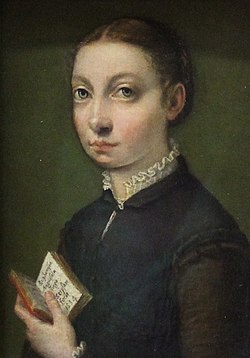Self-Portrait is a small oil-on-panel painting by the Italian artist Sofonisba Anguissola, signed and dated 1554 on the open book held by the artist.[1][2][3] The portrait is now in the Kunsthistorisches Museum, in Vienna.[4]
| Self-Portrait | |
|---|---|
 | |
| Artist | Sofonisba Anguissola |
| Year | 1554 |
| Medium | oil on panel |
| Dimensions | 19.5 cm × 12.5 cm (7.7 in × 4.9 in) |
| Location | Kunsthistorisches Museum, Vienna |
It was recorded as hanging in Vienna's Belvedere Gallery, already attributed to Anguissola but initially thought to be a portrait of infanta Isabella Clara Eugenia on her betrothal to her cousin Albert VII, Archduke of Austria which had therefore ended up in Vienna.[5][6] Flavio Carioli also came to this conclusion, but in 1885 Adolfo Venturi cited a letter sent to Ercole II d'Este, Duke of Ferrara in March 1556 by Anguissola's father with two paintings by her, a self-portrait intended for the duke's daughter Lucrezia and a Cleopatra (after a drawing by Michelangelo, probably a folio now in the Casa Buonarroti). Venturi also recorded that in 1603-1604 cardinal Alessandro d'Este gave some of his paintings to Rudolf II, Holy Roman Emperor.[7] Though no inventory of the paintings given to Rudolf survives, Venturi theorises that this self-portrait was one of them and the theory is accepted by all other art historians.[8]
Description
editSimplicity and modesty inspire this little portrait. The round and clear eyes create a dialogue with the viewer of this portrait. The gaze is frank, the chin strong-willed, the hairdo austere, the dress modest. The collar of the light white shirt swells at the neck, in small soft folds. The girl wears no jewels. A note of femininity escapes in the small curl that descends next to the ear.
The date is only one year earlier than that of the Game of Chess by the same painter, but at first sight this portrait seems to belong to a much more immature artistic phase. Some imperfections are also due to an old cleaning, too vigorous, which has removed the glazes. Anguissola's father, in sending the gift to Duke Ercole d'Este, apologized for certain inaccuracies, due to the fact that the portrait had been created looking in the mirror: in fact the hand seems slightly deformed.[9] Sofonisba wears the same dress and has the same hairstyle and expression in her Self-Portrait at a Spinet, kept in Naples.
References
edit- ^ "Sofonisba Anguissola – Smarthistory". smarthistory.org. Retrieved 2020-06-04.
- ^ King, Margaret L.. The Renaissance in Europe. Norway: Laurence King Publishing, 2003. P. 246.
- ^ King, Margaret L.. A Short History of the Renaissance in Europe. Canada: University of Toronto Press, 2016. P. 274.
- ^ "Selbstbildnis". www.khm.at (in German). Retrieved 2020-06-04.
- ^ Liana De Girolami Cheney, Alicia Craig Faxon, Kathleen Lucey Russo, Self-portraits by women painters, Aldershot, Brookfield: Ashgate, 2000, p. 51, SBN IT\ICCU\MIL\0472038.
- ^ Joanna Woods-Marsden, Renaissance self-portraiture: the visual construction of identity and the social status of the artist, New Haven - London, Yale University Press, 1998, p.101-103, SBN IT\ICCU\UFI\0310798.
- ^ (in Italian) AA VV, Sofonisba Anguissola e le sue sorelle, Milano, Leonardo arte, 1994, SBN IT\ICCU\VEA\0063954, page 11 (catalogue of an exhibition held in Cremona in 1994, Vienna and Washington in 1995.
- ^ AA VV, Italian women artists from Renaissance to Baroque, Milano, Skira, 2007, SBN IT\ICCU\VEA\0702687, page 110
- ^ (in Italian) AA VV, Sofonisba Anguissola e le sue sorelle, Milano, Leonardo arte, 1994, SBN IT\ICCU\VEA\0063954, pp 188–189 (catalogue of an exhibition held in Cremona in 1994, Vienna and Washington in 1995.